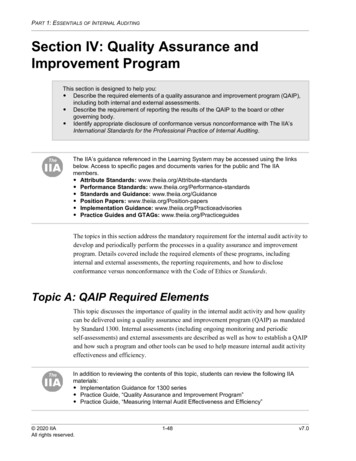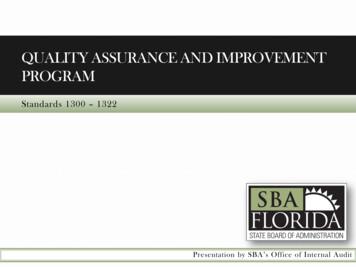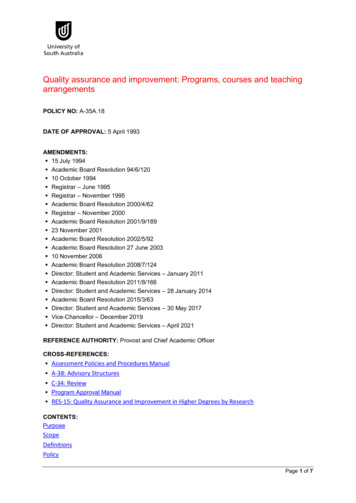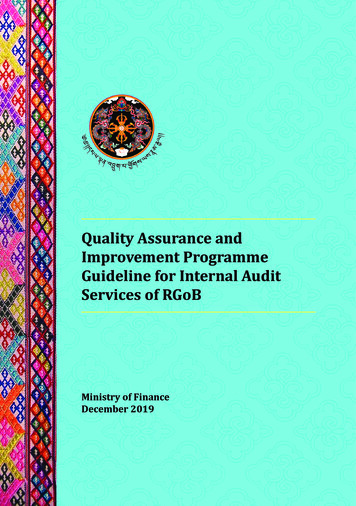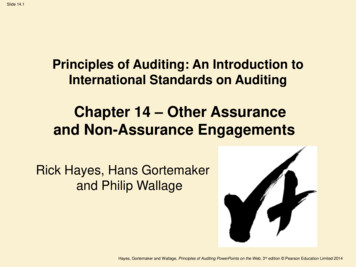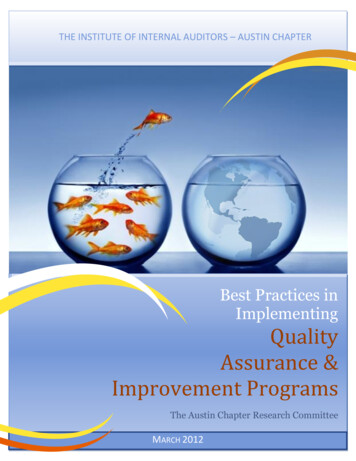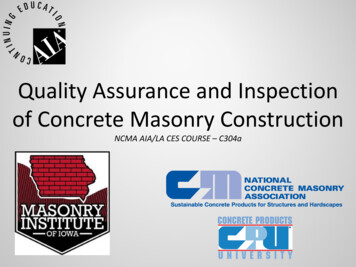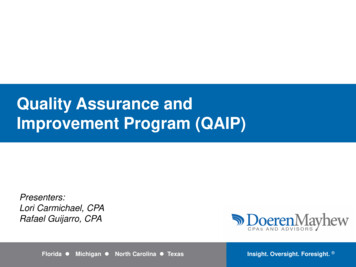
Transcription
Quality Assurance andImprovement Program (QAIP)Presenters:Lori Carmichael, CPARafael Guijarro, CPAFlorida Michigan North Carolina TexasInsight. Oversight. Foresight.
Class Overview Overview- QAIP The QAIP Framework Internal Assessments Periodic Self-Assessments Continuous Improvement External Assessments Full external assessment vs self-assessment Reporting Standards and Sample Test Procedures Keys to Success2
Overview-QAIP3Insight. Oversight. Foresight.
Overview- QAIP Standard 1300 –Quality Assurance and ImprovementProgram states “ The chief audit executive must developand maintain a quality assurance and improvementprogram that covers all aspects of the internal auditactivity” “Designed to enable an evaluation of the internal auditactivity’s conformance with the International Standards forthe Professional Practice of Internal Auditing (Standards)and whether internal auditors apply The IIA’s Code ofEthics.”4
Overview- QAIP Must include ongoing and periodic internal assessments,and external assessments by a qualified independentassessor or assessment team from outside theorganization. Quality built through internal audit methodology, policiesand procedures, and human resource practices.5
The QAIP Framework6Insight. Oversight. Foresight.
The QAIP Framework A framework can be used to describe the completeenvironment for developing and implementing the QAIP. Common elements include: A scope that includes all aspects of the internal audit activity An evaluation of conformance with the Standards and theCode of Ethics. An appraisal of the efficiency and effectiveness of theinternal audit activity. The identification of opportunities for continuousimprovement. Involvement by the board in oversight of the QAIP.7
Internal Assessments8Insight. Oversight. Foresight.
Internal Assessments Standard 1311- Internal Assessments states “ Internalassessments must include: Ongoing monitoring of the performance of the internal auditactivity. Periodic self-assessments or assessments by other personswithin the organization with sufficient knowledge of internalaudit practices.”9
Internal Assessments Ongoing (or Continuous) Monitoring- Determines whether theprocesses are delivering quality on an engagement-byengagement basis. Should occur routinely throughout the year throughimplementation of standard working practices. Adequate supervision is the most fundamental element of anyquality assurance process. Supervision begins with planning and continues throughout theperformance and communication phases of the engagement. Adequate supervision is ensured through work paper reviewprocedures, including timely sign-off by the individual responsible.10
Internal Assessments Mechanisms may be used for ongoing monitoring. Checklists or automation tools to provide assurance oncompliance with established practices and procedures. Acquiring feedback from management. Survey tool or conversation Using measures of project budgets, timekeeping systems,and audit plan completion. Budget to actual variance Key performance indicators such as number of certifiedindividuals in internal audit, years of experience, and traininghours earned each year.11
Internal Assessments Results of ongoing monitoring must be reported to theboard or the audit committee at least annually. Adequacy and effectiveness should be evaluated as partof the periodic self-assessments.12
Internal Assessments Periodic Self-Assessments have a different focus thatongoing monitoring in that they generally provide a moreholistic, comprehensive review of the Standards and theinternal audit activity. Periodic-self assessment- internal audit activity Ongoing monitoring-engagement level13
Internal Assessments Periodic Self-Assessments should validate conformance with theStandards and Code of Ethics. Additionally may evaluate: Quality and supervision of work performed Adequacy and appropriateness of internal audit policies and procedures The ways in which the internal audit activity adds values Achievements of key performance indicators Generally conducted by senior members of the internal audit activity. Including others may serve as a useful training opportunity to improvethe understanding of the performance standards.14
Internal Assessments Considerations for demonstrating conformance: Completed checklists supporting work paper reviews Survey results Budget vs actual analysis Documentation of periodic assessments Scope of review and approach plan Work papers Communication reports Presentations to the board and management Meeting minutes QAIP Results Corrective action plans15
Internal Assessments Considerations for demonstrating conformance(continued): Presentations to the board and management Meeting minutes QAIP Results Corrective action plans Corrective actions taken to improve conformance Actions take to improve efficiency and effectiveness16
Continuous Improvement17Insight. Oversight. Foresight.
Continuous Improvement Primary focus of the QAIP must be on evaluating conformancewith the Standards and the Code of Ethics, however, the realvalue to internal audit is from the focus on continuousimprovement. Embedding the concept of continuous improvement may resultin many additional benefits, such as: Positioning internal audit activity for success within theorganization Greater alignment with the organization’s strategies andobjectives Enhanced productivity Improved internal audit staff morale18
Continuous Improvement Organizations can use a gap analysis to compare currentperformance with desired future performance. Documentation on internal assessments should containsummaries of continuous improvement efforts within theinternal audit activity.19
External Assessments20Insight. Oversight. Foresight.
External Assessments The Institute of Internal Auditors’ (IIA’s) InternationalStandards for Professional Practice of Internal Auditing(Standards) requires external assessments to beconducted at least once every 5 years by an outside teamof independent assessors to evaluate an internal auditactivity’s conformance with the IIA’s Definition of InternalAuditing, Code of Ethics, and Standards.21
External Assessments Standards allow two forms of assessments: Full external assessment Conducted by a qualified, independent external assessor orassessment team. Self-assessment with independent external validation (Selfassessment) Chief Audit Executive (CAE) completes self-assessment work,evaluates conformance with the IIA’s mandatory guidance, andproduces a report summarizing assessment results. The independent external assessor validates the work of theinternal assessment.22
External Assessments Standard 2430, Use of “Conducted in Accordance withthe Standards” Internal auditors may report that their engagements areconducted in conformance with the Standards only if theresults of the quality assurance and improvement programsupport the statement. Penalty for non-compliance.23
Full External Assessment vsSelf-Assessment24Insight. Oversight. Foresight.
Full External Assessment vs SelfAssessment25Full ExternalAssessmentSelf-Assessment withExternal ValidationMeets requirements per StandardsMeets requirements per StandardsAssessment is conducted by qualified,independent external assessor or assessmentteamAssessment is completed by CAE and internalassessment teamExternal assessor produces reportsummarizing assessment resultsCAE produces report summarizingassessment resultsExternal assessor is responsible fordocumentation of assessmentCAE is responsible for documentation of assessmentand providing support to assessor for validationGenerally, higher fee than self-assessmentGenerally, lower fee than full externalassessment
Reporting26Insight. Oversight. Foresight.
Reporting The content of the report for an external assessmentshould contain the following: Objectives and scope Overall conformance evaluation (i.e., Generally Conforms,Partially Conforms, or Does Not Conform) Identification of any individual standards rated less thanGenerally Conforms, together with details of theobservation/finding, recommendations for improvement, andmanagement action plans An appendix that lists all of the Standards and theirindividual conformance levels Definition of terms used in the conformance ranking system27
Reporting The following content is also highly recommended: Executive summary Identification of noteworthy strengths Process improvement opportunities to help the internal auditactivity further add value Standards would be assessed using the GenerallyConforms, Partially Conforms, and Does Not Conformlevels.28
Reporting Generally Conforms The internal audit activity achieves general conformity with amajority of the individual standards and/or elements of theCode of Ethics, and at least partial conformity to others, withinthe section/category. For the internal audit activity overall, there may beopportunities for improvement, but these should not representsituations where the internal audit activity has not implementedthe standards or the Code of Ethics, has not applied themeffectively, or has not achieved their stated objectives.29
Reporting Partially Conforms The internal audit activity partially achieves conformance with amajority of the individual standards within the section/categoryand/or elements of the Code of Ethics. For the internal audit activity overall, there will be significantopportunities for improvement in effectively applying theStandards or Code of Ethics and/or achieving their objectives.Some deficiencies may be beyond the control of the internalaudit activity and may result in recommendations to seniormanagement or the board of the organization.30
Reporting Does Not Conform The internal audit activity does not achieve conformance with amajority of the individual standards within the section/categoryand/or elements of the Code of Ethics. For the internal audit activity overall, there will be deficienciesthat will usually have a significant negative impact on theinternal audit activity’s effectiveness and its potential to addvalue to the organization. These may also represent significantopportunities for improvement, including actions by seniormanagement or the board.31
Standards & Sample TestProcedures32Insight. Oversight. Foresight.
Standards & Sample Test ProceduresStandards Overview Attribute Standards Purpose, Authority, and Responsibility (1000) Independence and Objectivity (1100) Proficiency and Due Professional Care (1200) Quality Assurance Improvement Program (1300)33
Standards & Sample Test ProceduresStandards Overview Performance Standards Managing the Internal Audit Activity (2000) Nature of Work (2100) Engagement Planning (2200) Communicating Results (2400) Monitoring Progress (2500) Communicating and Acceptance of Risks (2600)34
Standards & Sample Test ProceduresPurpose, Authority & Responsibility (Standard 1000):Standard: “The purpose, authority, and responsibility of the internal audit activity mustbe formally defined in an internal audit charter, consistent with the Missionof Internal Audit and the mandatory elements of the InternationalProfessional Practices Framework (the Core Principles for the ProfessionalPractice of Internal Auditing, the Code of Ethics, the Standards, and theDefinition of Internal Auditing). The chief audit executive must periodically review the internal audit charterand present it to senior management and the board for approval.”35
Standards & Sample Test ProceduresPurpose, Authority & Responsibility (Standard 1000):Test Procedure: Review the internal audit charter specifically for: When it was last updated. Approval of the board. Formal definition of the purpose, authority, and responsibility of the internal audit activity. Alignment of the internal audit activity’s strategy (vision and mission) to that of the organization. Reporting lines of the internal audit activity. Incorporation of the mandatory nature of the Code of Ethics, the Definition of Internal Auditing,and the Standards. Legislation and regulations to which the internal audit activity must adhere. Statement of unrestricted access to all documents, people, and assets to perform engagements.36
Standards & Sample Test ProceduresIndependence and Objectivity (Standard 1100):Standard: “The internal audit activity must be independent, and internalauditors must be objective in performing their work.”Test Procedures: Identify the position of the internal audit activity within theorganization by reviewing the organization chart . Review the internal audit activity’s policies andprocedures regarding reporting of conflict of interest andreview conflict of interest declarations.37
Standards & Sample Test ProceduresProficiency & Due Professional Care (Standard 1200):Standard: “Engagements should be performed with proficiency and dueprofessional care.”Test Procedures: Review staff and management job descriptions (and anycompetency model or framework). Determine whether job descriptions (or the competency model) providesuitable criteria of education and experience for filling internal auditpositions. Determine whether the current auditors meet the specified criteria ofeducation and experience.38
Standards & Sample Test ProceduresProficiency & Due Professional Care (Standard 1200):Test Procedures: Review planning guide information pertaining to specializedskills required by the internal audit activity and the staffinganalysis (support for the current and prior year audit plans) Determine whether the current internal audit activity staff possesses adequateinformation technology (IT) audit skills Determine whether any other specialized skills or expertise (i.e., fraud detectionskills, consulting skills,
Standard 1300 –Quality Assurance and Improvement Program . states “ The chief audit executive must develop and maintain a quality assurance and improvement program that covers all aspects of the internal audit activity” “Designed to enable an evaluation of the internal audit activity’s conformance with the International Standards for



